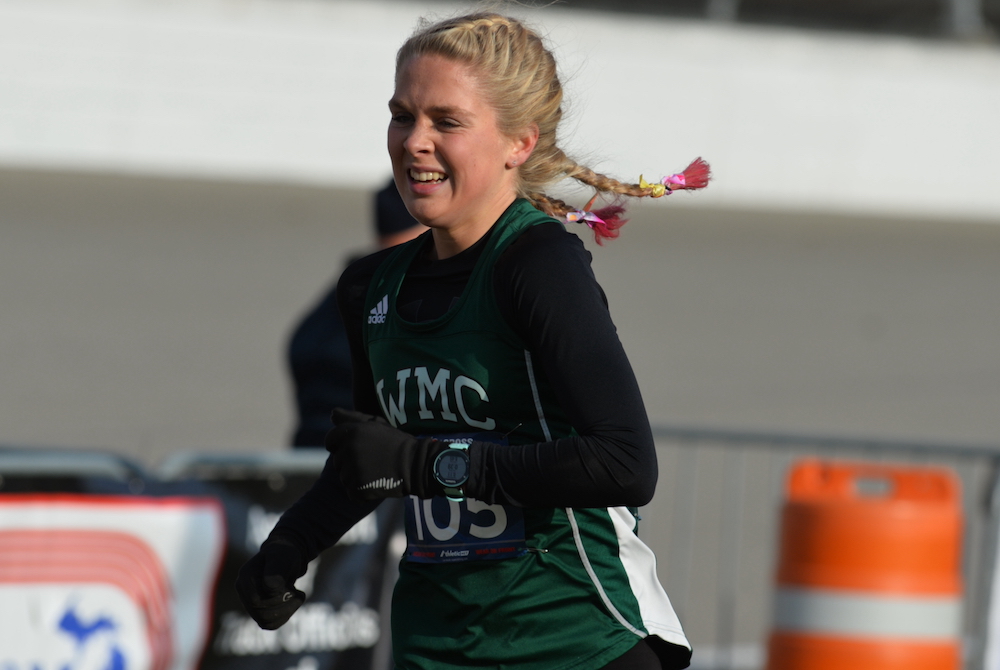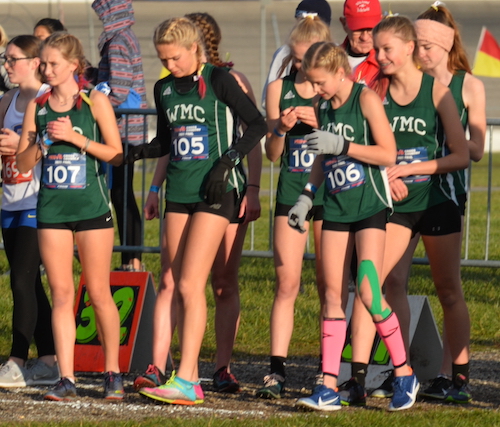
VanderKooi Joins Elite Champions Club, Leads WMC to 1st Team Title
November 6, 2021
BROOKLYN — Abby VanderKooi made it look easy for three years, dominating the small-school divisions at the MHSAA Lower Peninsula Cross Country Finals as one of the top runners in the nation.
But the 2021 season has been anything but easy for VanderKooi, and neither was the race in which the Muskegon Western Michigan Christian senior won her fourth MHSAA championship.
VanderKooi joined a select group of four-time champions by running a time of 18:06.58 Saturday at the Division 4 race at Michigan International Speedway.
As she crossed the finish line, completing her four-year mission, VanderKooi staggered a bit before gathering herself, even though the time wasn’t anywhere near her fastest.
“That hurt,” she said. “I was happy to be done. I saw the flag and I was like, ‘Oh, the gates of heaven!’”
VanderKooi finished third in the Foot Locker National Cross Country Championships as a freshman and sophomore before the 2020 race was canceled because of COVID. Along the way, she won the MHSAA LP Division 4 title in 2018 and 2019 and the Division 3 crown when her school moved up a division for one year in 2020.
VanderKooi became only the fourth girl to win four outright MHSAA Lower Peninsula individual championships.
The others are Carrie Gould of Burton Bendle and Flint Powers Catholic (1992-95), Katie Boyles of Rochester Adams (1997-2000) and Kirsten Olling of Breckenridge (2010-13). Amber Smith of Ishpeming Westwood (2000-03) and Tara Kiilunen of Calumet won four MHSAA Upper Peninsula titles.
Valari Ambrose of Riverview Gabriel Richard (1981-84) won the individual race four times, but only twice had the fastest time in Class C back when there were two races at the MHSAA Finals. Theresa Padilla of Camden-Frontier won four individual races from 1984-87, but had the fastest time in Class D only once.
“It’s really special,” VanderKooi said. “Not many people get to do that. I’m so thankful I have the ability to do that.”
 VanderKooi said she had trouble breathing in the cold air in the first race of the day at MIS. It was just one of several challenges she’s faced this year.
VanderKooi said she had trouble breathing in the cold air in the first race of the day at MIS. It was just one of several challenges she’s faced this year.
“I wonder if I have cold-induced asthma,” she said. “My sister does. I don’t have it as bad as her. I haven’t been having a good season; I don’t know why. I haven’t been able to click into it. Ever since I broke my toe in track season, I haven’t been able to get back into running fast times, so that’s been really frustrating.”
Unlike her past three MHSAA Finals, VanderKooi had company after the initial burst from the start line.
VanderKooi reached the mile mark in 5:47.9, with Buckley sophomore Aiden Harrand close behind at 5:49.5. The gap increased to nine seconds at the two-mile mark.
“I could hear her the whole time,” VanderKooi said. “When you hear people cheering for other people behind you, it’s kind of scary.”
With VanderKooi graduating, Harrand could be the heir apparent to the Division 4 throne. Harrand was fifth as a freshman.
Harrand’s plan Saturday was “just pretty much stay as close as I can and try to gap the move, move when she does and try my best. About the mile-and-a-half marker, she just had more in the tank than I did.”
For VanderKooi, her performance wasn’t all about individual glory. Her first-place stick helped Western Michigan Christian win its first MHSAA team championship by an 81-108 margin over Kalamazoo Christian.
Her freshman sister, Grace, took eighth in 19:28.28. Completing the team score were Ava Rotman (33rd, 20:41.09), Brianna Zuidema (36th, 20:43.09) and Eleanor Kingshott (59th, 21:12.33).
“Having my team along, especially my sister, it means the world to me,” Abby VanderKooi said. “I’ve never had so much fun with such a wonderful team.”
PHOTOS Muskegon Western Michigan Christian’s Abby VanderKooi travels the final stretch on the way to clinching her fourth MHSAA Finals individual title Friday. (Middle) The WMC runners prepare to begin Saturday’s Division 4 race; they’d go on to claim their first team title. (Click for more from RunMichigan.com.)

MHSAA Vault: MIS Rose to Challenges to Host 2020 LP Finals
By
Rob Kaminski
MHSAA benchmarks editor
November 12, 2021
The “MHSAA Vault” features stories from past publications and other documents in the MHSAA Library. This issue takes a look at the MHSAA Cross Country Finals at Michigan International Speedway, which celebrated 25 years in 2020 – although it was an event that nearly didn’t happen last fall …
In 1996, the MHSAA and Michigan International Speedway began a partnership the changed the course of the Lower Peninsula Cross Country Finals – quite literally.
The land in and around the track at Brooklyn would host the Finals for all classes of runners in one place on one day, an annual festival of nearly 2,000 runners competing for the MHSAA’s top honors.
Even skeptics – and there were several among running purists who thought the course was too flat, for example – can’t deny the results.
Finals attendance nearly doubled in that first year, and crowds in excess of 10,000 have enjoyed a day of racing several times, including a record 12,153 in 2011.
Enthusiastic crowds were the norm in recent years, with 11,232 in 2017, and nearly 11,000 in 2018 (10,989) and 2019 (10,873).
In fact, attendance failed to reach at least 8,000 only twice since the move to MIS.
Of course, last year was an exception, when attendance was limited to 1,000 spectators per session due to the COVID-19 Pandemic. Fans also were restricted to the grandstands rather than following the action throughout locations on the course.
To reduce the number of runners in each race, the event was spread over two days, with each Division being run in two separate “sections” with times then combined at the end to determine team and individual champions.
While not ideal, the end result was another year of fantastic efforts at MIS – both from student-athletes and those behind the scenes.
“Even at the last hour, less than a week ahead of the Finals, we were closer to not having the Finals than we were to having them,” said MHSAA Assistant Director Cody Inglis, who coordinates the cross country postseason. “Rumors and challenges of mandated shutdowns, testing and other requirements were being discussed and caused a lot of unknowns. Even at the Regional level, we had schools, Regional courses and hosts shutting down their facilities; we had to relocate four Regionals 48 hours prior to race times. That scenario just could not happen at the Finals level where far more runners and much more travel would be involved.”
Among the many last-minute hurdles was the edict from NASCAR – which owns MIS – that all persons on site be temperature checked upon entry. That meant securing thermometers that were easy to operate in short order, along with personnel necessary to conduct the readings.
The attendance limitations certainly helped to implement the temperature screening, but brought their own issues.
“Limiting spectators was not a popular decision, but it really was the only way to have a race,” Inglis said. “We were taking direction and working with policies and protocols from the MDHHS, the Governor’s office, Lenawee County Health Department, MIS and NASCAR.”
Part of the solution was to utilize the grandstands as a “barrier” between participants and spectators. The reduced number of fans were dispersed over thousands of seats while still allowing them the chance to watch their student-athletes compete.
“It wasn’t the same, it wasn’t easy or perfect, but it was what we had to do to have a race,” Inglis said. “Separating the Finals into two days and different sections also allowed us to spread out the event and limit the number of people on site at any one time. This was a key part of the plan and worked well even though it separated races within a Division.”
The MHSAA, MIS and the cross country community never lost focus of the main goal: a culmination of the season for the student-athletes, who deserved something last year more than ever. And, more than ever, MIS once again displayed its advantage as a venue that could adapt to the fluid nature of the times to pull off the event.
“There were some thoughts of using four different sites, but as we learned during the Regionals, the climate of things was so tenuous from one area of the state to another that we couldn’t be 100-percent certain that there wouldn’t again be last-minute cancelations,” Inglis said. “MIS was wonderful to work and collaborate with, and was the best option to get it done. It was never mentioned once publicly about the possibility of not having the Finals – only how we could best do it under uncharted conditions.”
The moving parts and ever-changing scenarios created more complexity than ever in finalizing a season, but every decision was made with the complete desire to conduct the Finals as close to normal as possible.
“I firmly believe that a finish to the season, no matter the differences in race formatting and fan experience, was something everyone would have taken when the season began in August,” Inglis said.
Indeed, the finish line in Year 25 at MIS might have been the most gratifying of them all.

